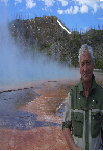
E.M. Galimov
Moscow State University
Russia
Title: The concept of origin of the Earth-Moon system from a supraplanetary gas-particles body.
Biography
Biography: E.M. Galimov
Abstract
Present knowledge of the Moon geochemistry allows formulation several constraints on its origin: The Moon and the Earth are identical in their isotopic features including similarity of the 16O-17O-18O fractionation lines and identical Ti, W, Cr, Mg, Si, Li isotopic compositions. The isotopic similarity indicates origin of the Earth and the Moon from the common source. On other hand they are different in chemical composition. The Moon contains much smaller iron core compared to the Earth. The Moon is enriched in refractory main rock forming elements such as Al, Ca, and Ti. The Moon is depleted in volatiles, including heavy volatiles, which could not be lost gravitationally, for instance Rb and Pb. The mega impact model fails to meet these constraints. The model that we have proposed suggests formation of the Earth and the Moon from initial large (within the Hill sphere) gas-particles body (cloud). Its contraction resulted in an adiabatic temperature increase in its interior part and partial evaporation of the particles. The vapor was expelled from the inter-particles space during contraction by the carrier gas, which are hydrogen and water. The latter forms due to reduction of the primordial FeO into elementary Fe. The hydrodynamic flow excludes isotope fractionation during escape of volatiles and explains the loss of the heavy elements (Rb, Xe, and Pb). We show that the iron may also escape in this process.
